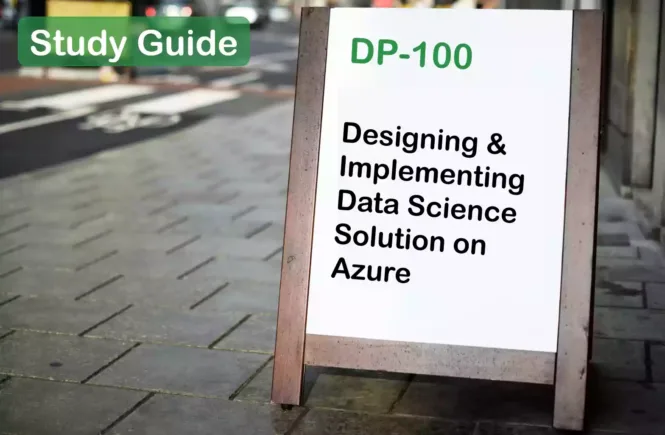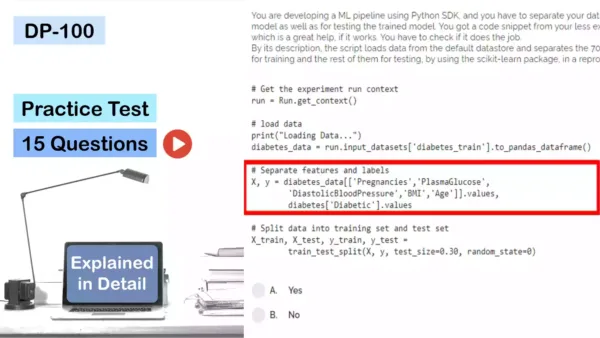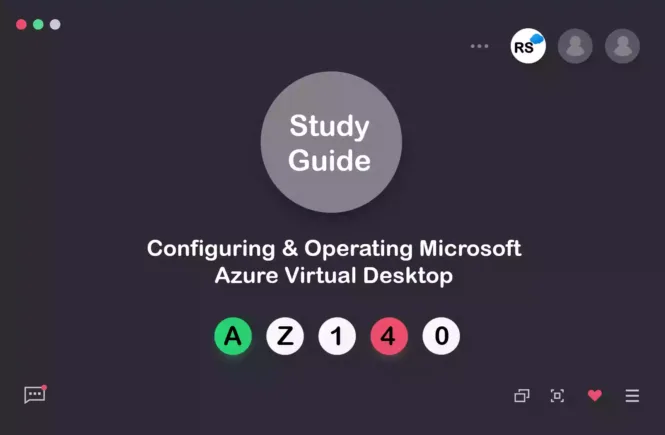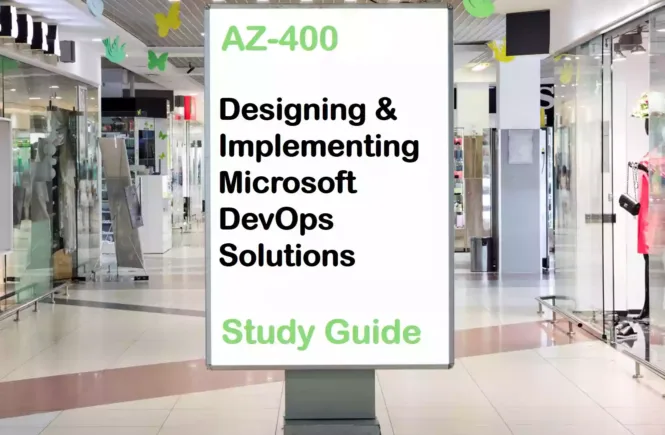DP-100 Preparation Details
Preparing for DP-100 Designing and Implementing a Data Science Solution on the Azure Certificate exam? Don’t know where to start? This post is the DP-100 Certificate Study Guide (with links to each exam objective).
I have curated a list of articles from Microsoft documentation for each objective of the DP-100 exam. I hope this article will help you to prepare for the DP-100 Certification exam. Also, please share the post within your circles so it helps them to prepare for the exam.
Exam Voucher for DP-100 with 1 Retake
Get 40% OFF with the combo
DP-100 Azure Data Science Online Course
| Pluralsight | Microsoft Azure Data Scientist Course |
| LinkedIn Learning (Free trial) | Azure Machine Learning Development |
| Udemy | A-Z Machine Learning with Azure ML |
DP-100 Azure Data Science Practice Test & Lab
| Whizlabs Exam Questions | Microsoft Azure Exam Certification Prep |
| Udemy Practice Tests | 170+ Azure Data Practice Exam Questions |
| Amazon e-book (PDF) | Data Science with Azure Machine Learning |
Other Data Science Learning Programs
| Coursera | Data Scientist Associate test prep |
| Udacity (Nanodegree) | Become an Azure Machine Learning Engineer |
| Datacamp | Data Science for all [Interactive course] |
Not Sure Which Exam Is Right for You?
Confused between AI-102 and DP-100? You are not alone. Read the AI-102 vs DP-100 blog post and choose the one that’s right for you!
DP-100 Sample Practice Exam Questions
Looking for DP-100 Dumps? Read This!
Using DP-100 exam dumps can get you permanently banned from taking any future Microsoft certificate exam. Read the FAQ page for more information. However, I strongly suggest you validate your understanding with practice questions.
Check out all the other Azure certificate study guides
Full Disclosure: Some of the links in this post are affiliate links. I receive a commission when you purchase through them.
Manage Azure Resources for Machine Learning (25-30%)
Create an Azure Machine Learning Workspace
Create an Azure Machine Learning workspace
Create & manage Azure Machine Learning workspaces
Configure workspace settings
Azure security workspace setting
Manage a workspace by using Azure Machine Learning Studio
Manage an Azure Machine Learning Studio workspace
Manage Data in an Azure Machine Learning Workspace
Select Azure storage resources
Connect to storage services on Azure
Register and maintain datastores
Create and manage datasets
Manage Compute for Experiments in Azure Machine Learning
Determine appropriate compute specifications for a training workload
Configure & submit training runs
Create compute targets for experiments and training
What are compute targets in Azure Machine Learning?
Set up compute targets for model training & deployment
Configure Attached Compute resources including Azure Databricks
Attach Azure Databricks compute resources to AML workspace
Monitor compute utilization
Monitor Azure Machine Learning
Amazon link (affiliate)
Implement Security and Access Control in Azure Machine Learning
Determine access requirements and map requirements to built-in roles
Default roles in the workspace
Create custom roles
Manage role membership
Manage roles in your workspace
Manage credentials by using Azure Key Vault
Use authentication credentials in AML
Set up an Azure Machine Learning Development Environment
Create compute instances
What is an AML compute instance?
Create & manage an AML compute instance
Share compute instances
Share compute instance with other users
Access Azure Machine Learning workspaces from other development environments
Organize and set up Azure Machine Learning environments
Use software environments in AML
Set up an Azure Databricks Workspace
Create an Azure Databricks workspace
Quickstart – Create an Azure Databricks workspace
Create an Azure Databricks cluster
Create a cluster in Azure Databricks
Create and run notebooks in Azure Databricks
Manage notebooks in Azure Databricks
Link an Azure Databricks workspace to an Azure Machine Learning workspace
Develop with AML & Azure Databricks
Run Experiments and Train Models (20-25%)
Create Models by Using the Azure Machine Learning Designer
Create a training pipeline by using Azure Machine Learning designer
Retrain models with Azure Machine Learning designer
Ingest data in a designer pipeline
Data ingestion options for Azure Machine Learning workflows
Use designer modules to define a pipeline data flow
Predict automobile price with the designer
Use custom code modules in designer
Define custom R modules for Machine Learning Studio (classic)
Run Model Training Scripts
Create and run an experiment by using the Azure Machine Learning SDK
Azure Machine Learning in Jupyter Notebooks
Configure run settings for a script
Configure and submit training runs
Consume data from a dataset in an experiment by using the Azure Machine Learning SDK
Create and register datastores
Run a training script on Azure Databricks compute
Develop with AutoML & Azure Databricks
Run code to train a model in an Azure Databricks notebook
Example of building ML models on Azure Databricks
Generate Metrics from an Experiment Run
Log metrics from an experiment run
Enable logging in Azure ML training runs
Retrieve and view experiment outputs
Evaluate machine learning experiment results
Set input & output directories
Use logs to troubleshoot experiment run errors
Collect ML pipeline log files in Application Insights for alerts & debugging
Use MLflow to track experiments
MLflow tracking for Azure Databricks ML experiments
MLflow tracking for ML experiments
Track experiments running in Azure Databricks
Track Databricks experiments in Azure Machine Learning
Use Automated Machine Learning to Create Optimal Models
Use the Automated ML interface in Azure Machine Learning studio
Forecast demand with automated machine learning
Use Automated ML from the Azure Machine Learning SDK
Configure automated ML experiments in Python
Select pre-processing options
Preprocessing Data in Azure Machine Learning Studio
What is automated machine learning (AutoML)?
Select the algorithms to be searched
How to select algorithms for Azure Machine Learning
Define a primary metric
Get data for an Automated ML run
Retrieve the best model
Tune Hyperparameters with Azure Machine Learning
Select a sampling method
Sampling the hyperparameter space
Define the search space
Tune hyperparameters for your model with Azure ML
Define the primary metric
Primary metric in Azure Machine Learning
Choosing a primary metric to handle imbalanced data
Define early termination options
Specify early termination policy
Find the model that has optimal hyperparameter values
Deploy and Operationalize Machine Learning Solutions (35-40%)
Select Compute for Model Deployment
Consider security for deployed services
Use TLS to secure a web service through Azure ML
Evaluate compute options for the deployment
Deploy models with Azure Machine Learning
Deploy a Model as a Service
Configure deployment settings
Deploy models with Azure Machine Learning
Deploy a registered model
Deploy machine learning models
Deploy a model trained in Azure Databricks to an Azure Machine Learning endpoint
Deploy models from Azure Databricks onto Azure ML
Consume a deployed service
Consume an Azure ML model deployed as a web service
Troubleshoot deployment container issues
Troubleshoot docker deployment of models with AKS & ACI
Manage Models in Azure Machine Learning
Register a trained model
Register your model (optional)
Monitor model usage
Monitor Azure Machine Learning
Monitoring data from Azure Machine Learning
Monitor data drift
Monitor data drift with Azure Machine Learning
Create an Azure Machine Learning Pipeline for Batch Inferencing
Configure a ParallelRunStep
Configure compute for a batch inferencing pipeline
Create & attach the remote compute target
Publish a batch inferencing pipeline
Run batch predictions using Azure ML designer
Run a batch inferencing pipeline and obtain outputs
Build an Azure ML pipeline for batch scoring
Obtain outputs from a ParallelRunStep
Publish an Azure Machine Learning Designer Pipeline as a Web Service
Create a target compute resource
Deploy models with Azure Machine Learning
Configure an Inference pipeline
Deploy a machine learning model with the designer
Consume a deployed endpoint
Deploy models with Azure Machine Learning
Implement Pipelines By Using the Azure Machine Learning SDK
Create a pipeline
Use automated machine learning to predict taxi fares
Pass data between steps in a pipeline
Pass data between pipeline steps
Run a pipeline
Running automated machine learning experiments
Monitor pipeline runs
Monitoring Azure Machine Learning
Apply ML Ops Practices
Trigger an Azure Machine Learning pipeline from Azure DevOps
Trigger Azure Machine Learning pipelines
AML pipeline using CI/CD with Azure DevOps
Enable CI/CD for ML project with Azure Pipelines
Automate model retraining based on new data additions or data changes
Retrain your model on new data
Retraining & updating AML models
Refactor notebooks into scripts
Convert notebook code into Python scripts
Implement source control for scripts
Git integration for Azure Machine Learning
Using Azure Machine Learning from GitHub Actions
Implement Responsible Machine Learning (5-10%)
Use Model Explainers to Interpret Models
Select a model interpreter
Model interpretability in Azure Machine Learning
Explainability in automated ML
Interpret & explain ML models in Python
Generate feature importance data
Generate feature importance values
Permutation Feature Importance
Describe Fairness Considerations for Models
Evaluate model fairness based on prediction disparity
Assess ML models’ fairness in Python
Mitigate model unfairness
Detect & mitigate unfairness with AML models
Describe Privacy Considerations for Data
Describe principles of differential privacy
Differential privacy in machine learning
Specify acceptable levels of noise in data and the effects on privacy
Use differential privacy in Azure ML
This brings us to the end of the DP-100 Designing and Implementing a Data Science Solution on Azure Study Guide.
What do you think? Let me know in the comments section if I have missed out on anything. Also, I love to hear from you about how your preparation is going on!
In case you are preparing for other Azure certification exams, check out the Azure study guide for those exams.
Follow Me Receive Updates on DP-100 Exam
Want to be notified as soon as I post? Subscribe to the RSS feed / leave your email address in the subscribe section. Share the article to your social networks with the below links so it can benefit others.









34 Comments
What is the best practice exam question is available.
DP-100 Azure Practice Tests Prep Exam – looks like this is outdated. Could please guide more about exam question.
Sorry, I am not sure which provider has constantly updated his practice test
When you was preparing which practice test was near to actual exam. Please help
Hi Ravi
Amazing repository of resources required for the exam. So, first of all thank you for that.
I just wanted to know if the resources provided in this page are enough to clear the DP100 exam, in addition to the ML knowledge beforehand. Will I need to go deeper into each of the topics mentioned in this page?
Additionally, does the content here reflect the changes that will occur once the new exam starts rolling in.
Hello Shubham, the resources on the page point you in the right direction. I will not say it is enough, it is always better to go deep.
As the exam objectives change, I will update this page.
The information that you have shared is really useful for everyone.
Welcome
Hi,
Can someone who doesn’t have any knowledge about Azure also clear this test if I follow any learning path? I do have knowledge about Machine Learning in Python but I haven’t used Azure.
yes, possible
Do we need to write any code in the exam? Where do we get the execution environment?
Code generally are not asked in the exam. If any, you may have to select the right option (that has code in the list of options).
For now, labs aren’t there I guess.
Hi Ravi,
How much do you have to score to pass DP-100 certification exam?
700 for all exams
Hello, Ravi: Thanks for the study guide. What is your take on the exam? Is Microsoft going to test you on your data science knowledge or Azure features to support ML?
Also, I believe that the Udemy course you suggested is kind of outdated (2017).
And what is the link to the “All Azure Certification Courses for 9$”? Do you suggest to enroll in that?
Best regards,
Jason
Hello Jason,
Of course, I would think data science knowledge as a prerequisite, so someone already working as a data scientist is prime for this certification.
That $9 Monthly subscription does not include content related to dp-100 certification, so if you are looking to get certified in dp-100, I won’t suggest.
Can you please mention how many case studies and how many lab need be completed in the test? The exam pattern is changing frequently and most of the youtube materials are out-dated. Thanks in advance.
I am sorry, exactly no one can be sure of that
Hi Ravi
some one said they got questions on scikit-learn, RNN, DNN, ANN, statistics, brainscript, normalization, sentiment analysis, language translation, model optimization, weka, docker, Azure machine learning studio, Azure machine learning service, devops in machine learning, bandit problem, early stop strategies, evaluation metrics, cross-validation, smote, sequence model, hyperparameter tuning, automated machine learning in Azure, tensorflow, keras, data types (do read this to get some questions right), padas data frame melt(), spark, azure data bricks, notebook, zeppelin notebook on spark, feature selection, sampling, algorithm selection (boosted decision tree, regression etc)and others. could this be true as the objectives says nothing about this.
They may not be directly tested, yeah, but Microsoft expects you to be comfortable with those. See the exam prep video here
https://www.youtube.com/watch?v=mM5o14i_BCM&t=838
I am currently training on the dp-100 on the Microsoft learning path. The training does not cover Machine leaning studio or designer (Just Machine learning sdk). I am quite confused because the syllabus says Machine learning studio would be covered but their training states otherwise(https://docs.microsoft.com/en-us/learn/paths/build-ai-solutions-with-azure-ml-service/). Shouldn’t this Microsoft training just suffice.
Hello Sean,
I have observed that their learning paths do not cover all the exam objectives. So go by the official exam objectives. Refer to this guide or Microsoft docs for the objectives left out
Hi Ravi,
can we give exam using the replay offer of microsoft where we can attempt twice.
Yes, of course, Deepak, why not
i think the sample actual questions circulating online are actually outdated? like the below, i dont see topic like that in the course training i attended lately. please help to verify
You are developing a hands-on workshop to introduce Docker for Windows to attendees.
You need to ensure that workshop attendees can install Docker on their devices.
Which two prerequisite components should attendees install on the devices? Each correct answer presents part of the solution.
Each correct selection is worth one point.
NOTE:
A. Microsoft Hardware-Assisted Virtualization Detection Tool
B. Kitematic
C. BIOS-enabled virtualization
D. VirtualBox
E. Windows 10 64-bit Professional
yea, don’t seem to be dp-100
Hi,
Is ML Studio (classic) content still be available in the exam since Microsoft encourage user move to Azure Machine Learning designer?
Mostly on designer. there were only a couple of objectives from studio
Hi Ravi, I am currently preparing for the DP-100 certification. I wanted to know if the pluralsite course is more than enough for the preperation?
Pluralsight is very exhaustive. Use them as a reference
Just to be clear, do you mean its only good to reference or that its good enough to learn exclusively from?
I have not checked out each and every course in the path, but at one glace, they do cover most of it.
I think it’s not up to date anymore
Thanks for the feedback. I will update as soon as possible
It is updated